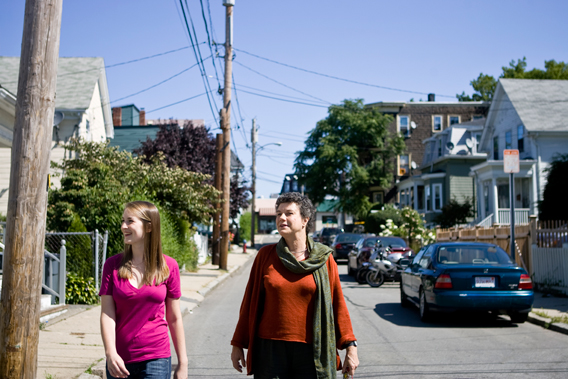Subprime Blues
A Summer Scholar charts the repercussion of the housing crisis in Somerville
By Marjorie Howard
Emily Morgan, A10, became very familiar this summer with the details of what usually only becomes a worry for people long after college: mortgages.

Emily Morgan, A10, left, has been studying the effects of subprime mortgages on Somerville as part of a Summer Scholars project with Anna Hardman, an economics lecturer. Photo: Joanie Tobin
Morgan pored over census records and made visits to the Middlesex County Registry of Deeds to learn about subprime mortgages, those loans for people who do not qualify for conventional financing. Subprime mortgages usually charge higher interest rates than other loans and often have variable interest rates. The first symptom of the current housing crisis was a high number of people defaulting on such loans and losing their property to foreclosure.
A double major in economics and French, Morgan became interested in the housing crisis after taking a course on the economics of public policy with Anna Hardman, a lecturer in economics. Morgan wrote a paper on housing markets and homelessness and then proposed a second project: studying the impact of subprime mortgages and foreclosures in the city of Somerville.
During the summer, Hardman served as Morgan's mentor on the project, part of the Summer Scholars program, in which students are selected to work with a professor on a research project. The program began in 2003, when the Task Force on the Undergraduate Experience recommended providing opportunities for students to conduct substantive research under the guidance of faculty members. This year there were 50 Summer Scholars.
Morgan began by investigating where recent Somerville foreclosures were concentrated-the underlying theory being that that they would reflect areas where a higher proportion of recent home buyers had taken out subprime mortgages.
"We hypothesized that they would likely be in neighborhoods with lower incomes and with a higher proportion of recent movers who are owners and also with more immigrant owners," says Hardman. "It subsequently became clear that a good many foreclosures affected owners of multi-family buildings. Emily is currently exploring the data to understand that phenomenon better."
Morgan began her research by tracking all the foreclosures in Somerville for the past 10 years, sifting through mounds of records at the Middlesex County Registry of Deeds.
"What I found was startling," she says. "Ten years ago there were between one and five foreclosures per year up until 2005, when there were nine. And in 2007 there were 36. This year, by the end of May, there were 22."
Now Morgan is compiling a database that she hopes will help predict what characteristics in a census tract make it more vulnerable to foreclosures, using information from the Federal Reserve Bank of Boston and from the Warren Group, a property data source. She is also looking at how Somerville's recent experience with foreclosures compares with other Boston-area communities by examining characteristics such as median income, immigrant population, concentration of population and the pace of recent housing price changes.
Hardman is pleased with Morgan's progress. Now in her junior year, Morgan will continue with the project and write a research paper. "Part of the point of this research is learning to live with the uncertainty about what you'll find," says Hardman. "You start out with a simple hypothesis, and in the course of exploring the data and testing it, you often modify it or develop new hypotheses. I would be worried if Emily had all the answers at this stage."
Marjorie Howard may be reached at marjorie.howard@tufts.edu.


